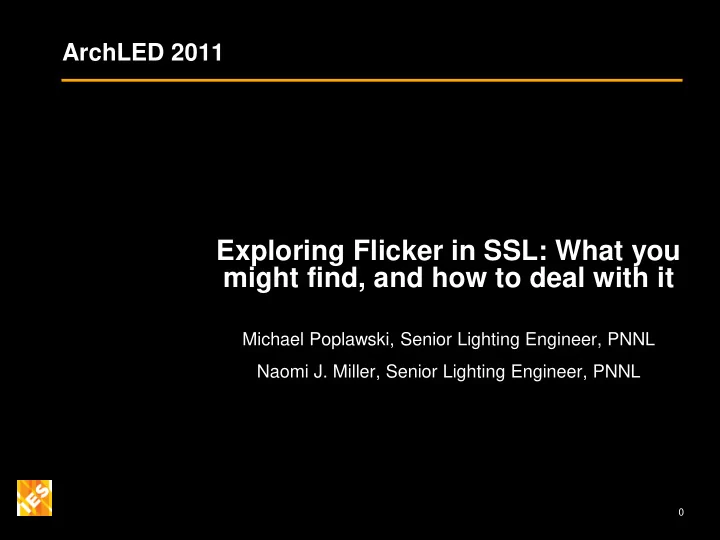

ArchLED 2011 Exploring Flicker in SSL: What you might find, and how to deal with it Michael Poplawski, Senior Lighting Engineer, PNNL Naomi J. Miller, Senior Lighting Engineer, PNNL 0
Flicker - Terminology Flicker, flutter, shimmer Repetitive change in magnitude over time, or modulation, of the luminous flux of a light source Light source modulation Visible, invisible, perceptible, detectable (sensation) Visible flicker = Luminous modulation is sensed and perceived Invisible flicker = Luminous modulation is sensed, but not perceived Sensation: External conditions are detected; neurons respond 1
Flicker Factors Flicker factors for both Visible and Invisible Flicker Modulation Frequency Modulation Amplitude DC Component Duty Cycle
Flicker - Metrics IESNA has defined two metrics for flicker: • Percent flicker – 0-100% scale – Older, but more well-known and more commonly used – Also referred to as Peak-to-Peak Contrast, Michelson Contrast in literature – Accounts for average, peak-to-peak amplitude – Does not account for shape, duty cycle, frequency Source: IESNA Lighting Handbook, 9th Edition • Flicker index – 0-1.0 scale A - B • Percent Flicker = 100% X – Newer, but less well-known and A + B rarely used Area 1 – Accounts for average, peak-to- • Flicker Index = Area 1 + Area 2 peak amplitude, shape, duty cycle – Does not account for frequency 3 www.ssl.energy.gov 3 | Solid-State Lighting Program
Incandescent, Halogen, Metal Halide lighting BK 08-94A BK 10-X-37A 20W Halogen MR16 60W A19 BK 10-21D BK 09-111D 25W Self-Ballasted (Electronic) 35W Halogen MR16 Source Ceramic Metal Halide PAR38 : 4 Michae www.ssl.energy.gov 4 | Solid-State Lighting Program l
Magnetically-ballasted Electronically-ballasted BK 10-X-28 BK 10-X-32 A19 CFL T12 Fluorescent BK 10-X-33 BK 10-X-34 Quad-Tube CFL Quad-Tube CFL 5 www.ssl.energy.gov 5 | Solid-State Lighting Program
What about solid-state lighting (SSL)? 07-23A 09-20A A-lamp/G-lamp A-lamp/G-lamp 10-28D 09-21A A-lamp/G-lamp A-lamp/G-lamp Source : Michae 6 www.ssl.energy.gov 6 | Solid-State Lighting Program l
SSL: (almost) anything is possible … 07-14B 07-18B R30/PAR30 R30/PAR30 09-76D 09-112A R30/PAR30 R30/PAR30 Source : Michae 7 www.ssl.energy.gov 7 | Solid-State Lighting Program l
SSL: (almost) anything is possible … 08-131A 10-11A R38/PAR38 R38/PAR38 07-53A 08-133C MR16 MR16 Source : Michae 8 www.ssl.energy.gov 8 | Solid-State Lighting Program l
SSL: (almost) anything is possible … 10-X-14 10-X-35 “AC LED” Module 2’ x 2’ troffer 07-61 09-44 2” downlight 4” downlight Source: Michael 9 Poplaw www.ssl.energy.gov 9 | Solid-State Lighting Program ski,
What makes flicker worse Duration of exposure (longer is worse) Area of the retina receiving stimulation (greater is worse) Location in visual field (central is worse because it projects to a greater area of the visual cortex, even though flicker is less noticeable) Brightness of the flash (higher luminances are worse; scotopic luminances produce low risk, high mesopic and photopic luminances produce higher risk) Contrast of the flash with the surround luminance (higher is worse) Color contrast of flash (deep red is worse)
How can you tell if a product flickers? No reliable metric is reported by manufacturers See the product in person, with the same driver/transformer/dimming setting of final installation Try a flicker wheel or a spinning top Sometimes a digital camera will pick up flicker Wave your fingers in the light; look for strobe effect
Flicker Implications 1 Headaches (see Wilkins et al) and Eyestrain Slower onset, to frequencies in range 100- 120 Hz have been demonstrated Exact population frequency isn't known; not everyone is affected Evidence comes primarily from fluorescent ballasts
Flicker Implications 2 Neurological problems including epileptic seizure Photosensitive epilepsy Short exposure to 3 – 70 Hz flicker (i.e., visible modulation) may cause seizures in sensitive people Also static repetitive geometric patterns 1 in 4000 people Onset around puberty; 75% remain sensitive for life Autistic sensitivity (Autism rates >1 in 110)
Flicker Implications 3 Visual performance Longer exposures to 100-120 Hz modulation, (i.e., not perceived as flicker) have been shown to reduce group average performance on visual tasks, both when viewed on paper and on CRT screens. (Veitch and McColl 1995)
Flicker Implications 4 Distraction Hazard from strobe effect stopping or slowing apparent motion of machinery
Where Flicker Matters General lighting Classrooms Hospitals/clinics Task lighting Industrial spaces Offices
Where flicker is less important Sports and industrial Roadways/parking lots lighting on 3-phase electrical system Accent lighting on artwork Very low intensity holiday lighting?
Where flicker might be an advantage Warning lights Discotheques (Just please avoid the epilepsy frequencies and use for very short duration)
Products more likely to Flicker AC LEDs DC LEDs with simple/inexpensive drivers (e.g. inadequate capacitors) Integral lamp LEDs on some electronic transformers LEDs dimmed with chopped wave form dimmers (triac, e.g.) LEDs dimmed with Pulse Width Modulation (PWM) dimmers
Dimming of LEDs Potential problems of dimming • No dimming response – On or Off • Unstable reduction in light output • Unacceptably high “low end” • LED product flickers or flashes or buzzes or hums • Repetitive peak currents from LED increase “effective wattage” seen by the dimmer Industry has no accepted definition of “dimmable” Good dimming requires compatibility of LED, driver, and dimmer; and careful lamp/fixture counts on circuit 20
Complicated Balance for LED drivers Cost, size, efficiency, Low flicker? reliability, power factor, lifetime?
Conclusions Researchers and industry need to develop reliable predictive flicker metrics Flicker metrics need to be verified with human factors and medical research Researchers and industry need to create a matrix of risk severity for different applications Typical Risk Matrix Example (Mil-Std 882)
Conclusions IEEE PAR1789 Committee intends to provide a recommended practice for how to apply flicker information Designers need to understand and apply the new flicker metrics and risk matrix Third-party testing may be needed for interaction of dimmer and LED products
What you might find and what you can do about it Pesky questions, please! Michael.Poplawski@PNNL.gov Naomi.Miller@PNNL.gov www.ssl.energy.gov 24 | Solid-State Lighting Program
Recommend
More recommend